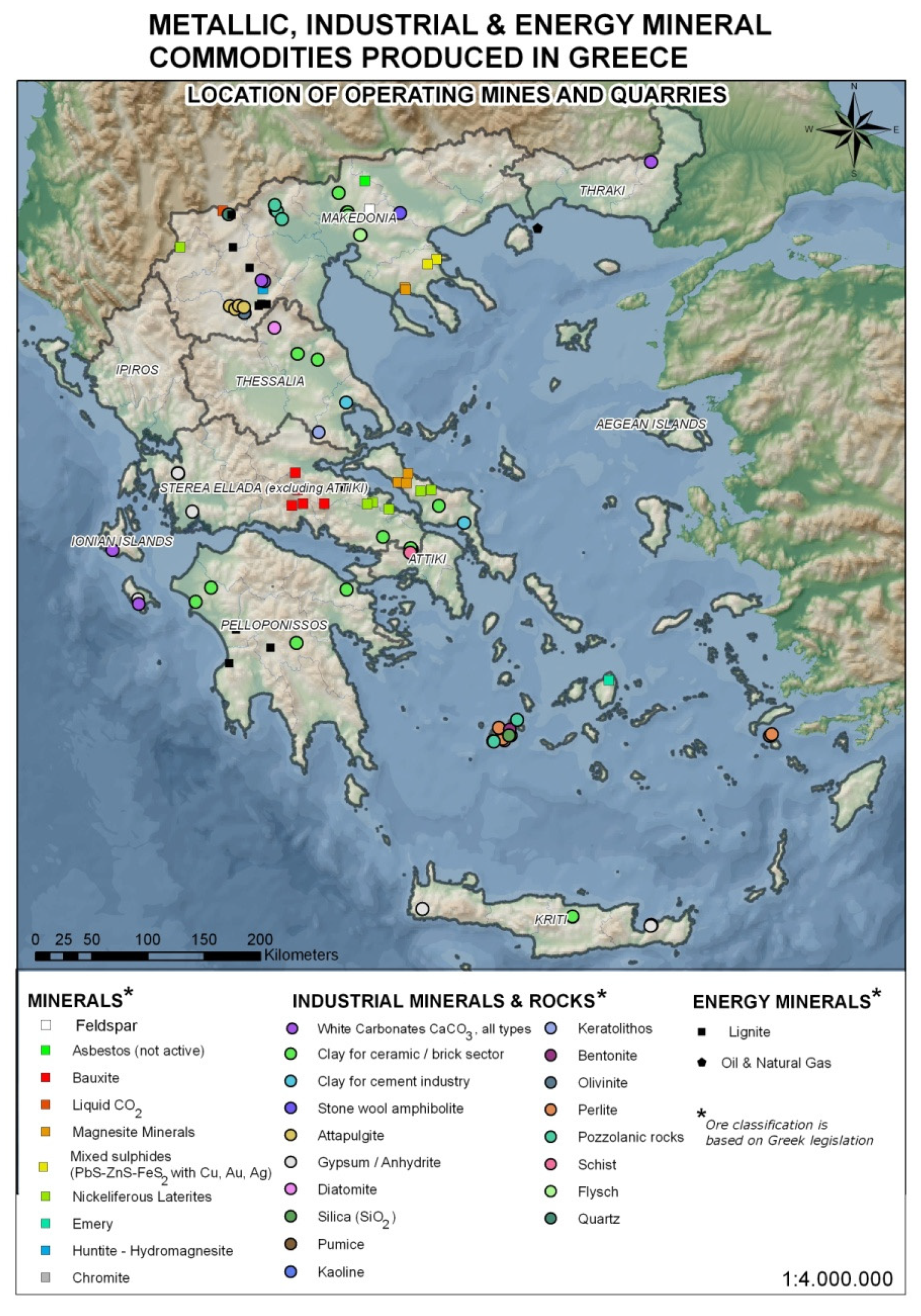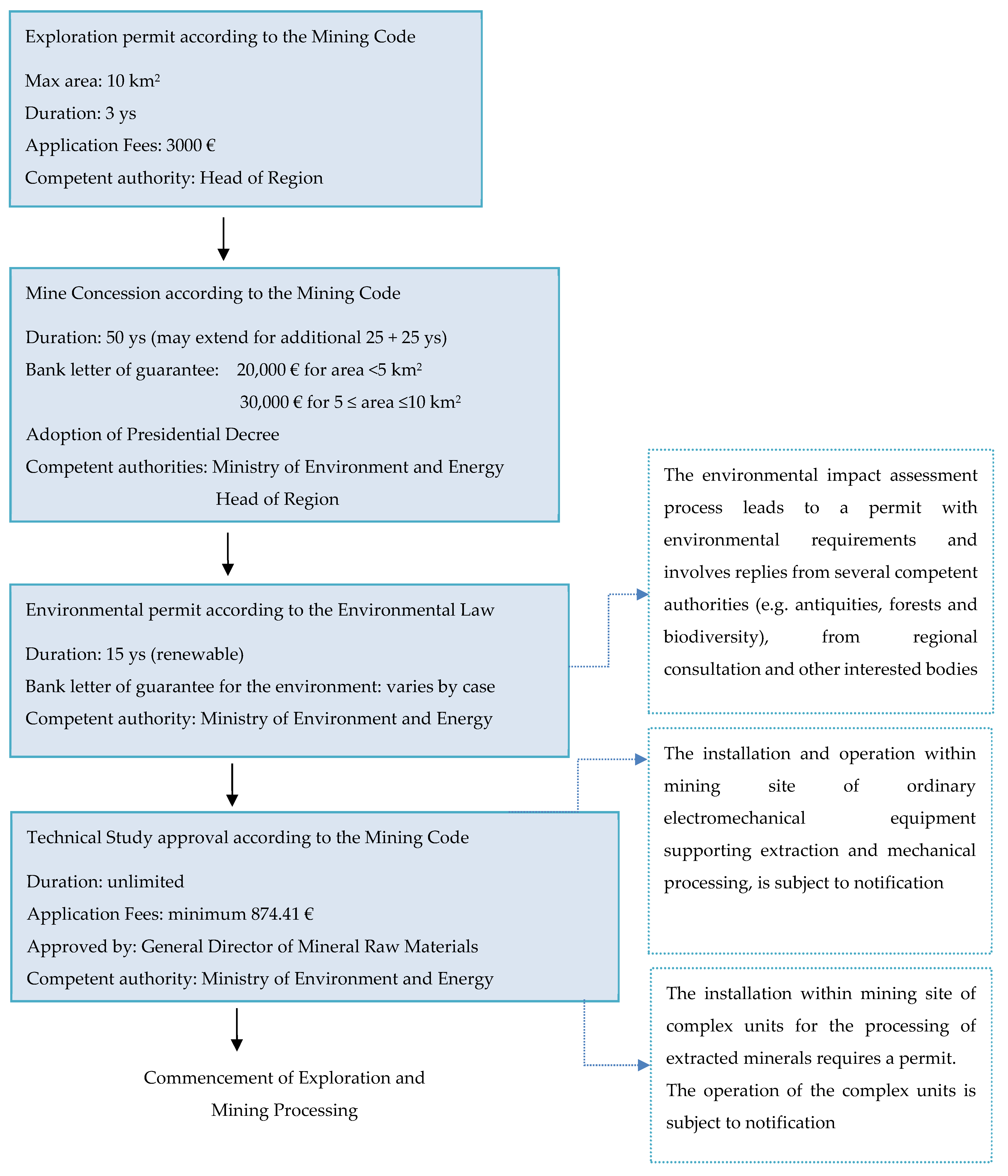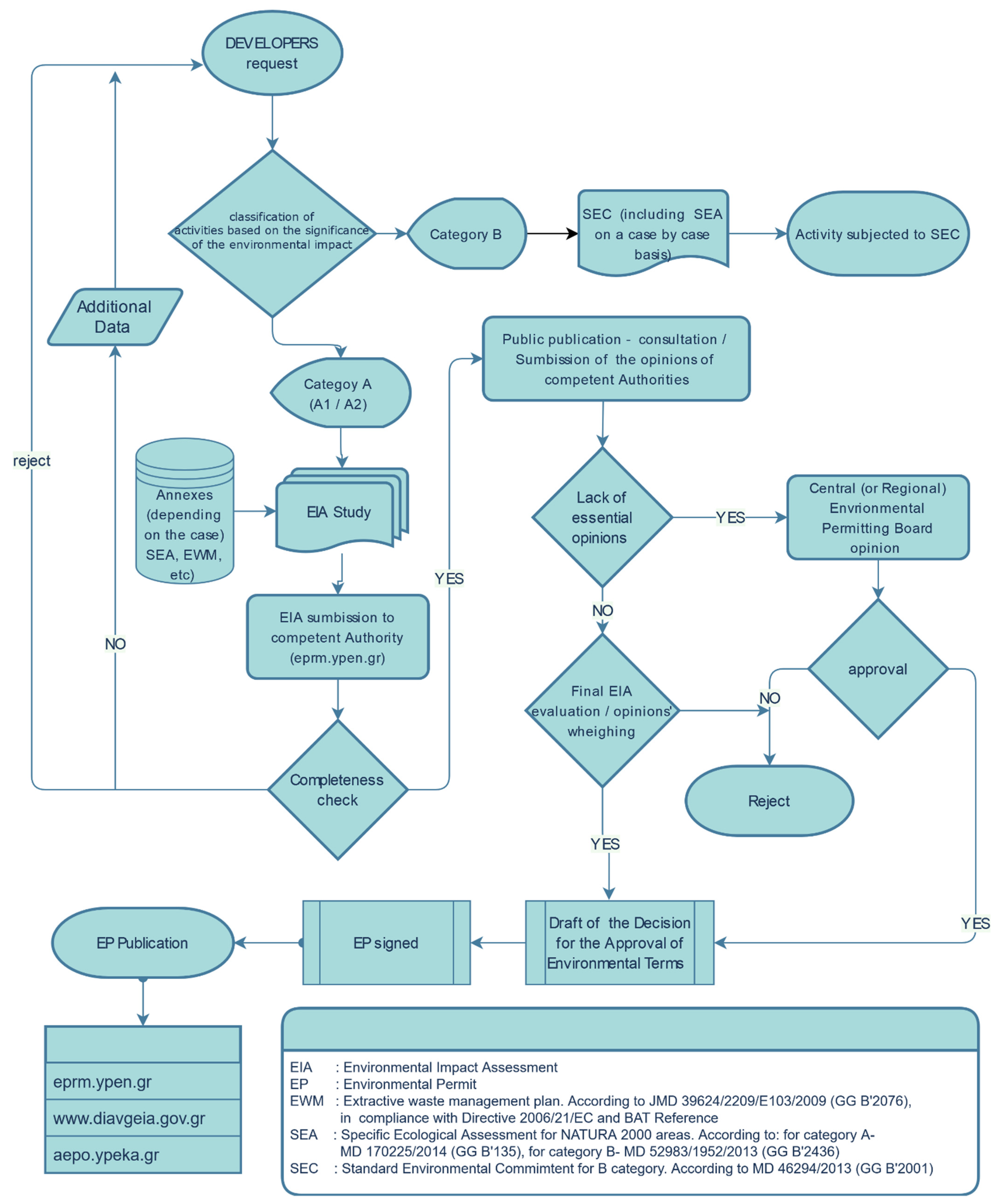1. Introduction
The permitting system for mineral exploration and exploitation in Greece consists of two regulatory pillars, based on mineral raw materials categories. In this regard, the Mining Code applies to the permitting of all types of metalliferous ores except of those that are State-owned or covered by the Quarrying Law, which in turn applies to quarried raw materials such as marble, industrial minerals and aggregates in accordance with the Environmental Protection Act, setting up the existing legal regime. Field operations are managed through the Regulation on Mining and Quarrying Works.
Since governance couples minerals legislation, competent authorities and permitting/auditing regimes, it could either encourage or hinder investments in mining. Factors that may affect the investment perspective could be ascribed to a plethora of intervening competent authorities, lengthy or even indeterminable permitting timeframes, non-standard requirements and reporting, and lack of updated information regarding mining potential.
This article presents a roadmap related to the processes required for current and future mineral resource investments and granting of permits in Greece. It contains information about the mining opportunities for critical raw materials and clarifies the procedures defined by law, and thereby facilitates decision making processes.
This roadmap could act as a useful informative tool for both the raw materials community and the public.
2. Greece’s Present Extractive Activity and Future Mining Opportunities
The mining industry constitutes an important factor in the economic development of the country, since it accounts for almost 3% of the GDP [
1]. The sector supplies essential raw materials for primary industries such as cement, energy, non-ferrous metals, the EU stainless steel industry, etc. The estimated sales of the country’s mineral industry including domestic processing industries totals almost EUR 1.8 billion [
2]. In terms of employment, the industry provides approximately 11,300 direct jobs in mines, quarries and in one out of two metallurgical plants [
2]. Since extraction and processing of raw materials take place within the region in which the deposits are found, the mining industry contributes considerably to local and regional growth and development.
Greece is a major global producer of several key minerals, notably perlite (of which Greece is the second-largest producer worldwide), bentonite (4th), magnesite (8th), and bauxite (15th) [
3], as shown in
Table 1; their spatial distribution is shown in
Figure 1. Greece is the world leader in production of ferronickel, and 5th within the EU in aluminium and alumina production, under a fully vertical integrated process.
Considering the intensified effort towards achieving a set of challenges to enable Europe to become the first climate-neutral continent by 2050 at the latest, the production and supply of common and rare metals is of high priority. Energy storage, in particular Lithium ion batteries, rely on access to huge quantities of specific metals and special chemistry requirements, as shown in
Figure 2.
Based on a medium-scale scenario, from the perspective of 2030 the EU would demand the additional supply of 83,000 tonnes of Cobalt, 61,000 tonnes of Lithium, 3820 tonnes of Neodymium and Dysprosium, and 196,000 tonnes of Copper in order to improve and secure its technological and industrial sovereignty in strategic sectors such as batteries, PVs, electromobility, wind power, storage and digitization [
4].
The EU has little or no domestic primary or secondary production of all these valuable raw materials, and is heavily dependent on imports from third countries despite its promising mineral potential for developing home production, as highlighted in many national and EU-funded mineral-related projects [
5].
Greece’s mineral potential is largely contained in State-owned areas, and includes resources such as alluvial gold, stibnite, barite, bauxite (including rare earths), chromite, copper (in both oxidized and sulphide forms), dolomite, emery, feldspar and quartz (silicon), gold, graphite, hydromagnesite, huntite, iron, magnesite, manganese, mixed sulphides (iron, zinc, lead, silver), molybdenite, nickel–cobalt laterite, phosphorite (including rare earths), other rare earths, scheelite (tungsten), talc, uranium, and vermiculite. The country’s large indicated reserves of some of the above minerals, shown in
Table 2, are based on the Hellenic Survey of Geology and Mining Exploration estimates of selected State-owned mining areas, taking into account, however, that due to the absence of updated research the presented reserve data are not complete [
7].
The above mineral raw materials include all the urgently sought-after contemporary EV battery raw materials, including nickel, cobalt and manganese. The first two metals are found in unique Greek dry nickel- and cobalt-containing laterites, which are currently being exploited only for their nickel content to produce ferronickel alloy suitable for stainless steel production [
8]. The cobalt content is not produced separately, as in this case a new hydrometallurgical process would have to be introduced. The third battery metal, manganese, is not exploited today in Greece; however, there was intensive historical exploitation of battery-grade manganese for conventional lead–acid–manganese dioxide–zinc battery manufacturing [
9].
Other critical and equally sought-after metals and minerals, include high-purity silicon, indium, tellurium, and gallium, which are useful for microchips, photovoltaics and wind turbines, and may also be recovered in certain State Mining Areas, which are highly prospective for rare earths since their historical exploration was limited to basic and precious metals. Silicon is already being exploited in the Florina and Kozani prefectures. Full details of State Mining Areas may be obtained on demand from the Directorate of Metallic, Energy and Industrial Minerals.
3. The Legislative Framework for Mining and Quarrying Works
3.1. In Brie
The Mining Code (Legislative Decree 210/1973 as amended by Law 274/1976 and later laws) governs onshore and offshore mineral exploration and development in Greece except energy minerals in liquid and gaseous forms, i.e., oil and gas, and applies to the mining of metallic minerals, metals and metallic compounds (i.e., base and precious metals), precious stones, radioactive and energy minerals (in solid form), organic sediments, and magnesite as well as some industrial minerals (i.e., feldspar, etc.,) existing either on the surface or underground. The legal characterization of a mineral as metallic is based on market economic importance rather than on scientific definition. The Mining Code regulates mineral exploration and exploitation rights, which are completely decoupled from land ownership. Taking into account that beyond state-owned minerals such as energy and radioactive minerals and the mining sites excluded in favor of the State, the right to hold a mining title can be conceded to any developer interested under the presumptions of this law.
The Quarrying Law (L.4512/2018) sets the provisions for the exploration and extraction of non-metallic minerals such as industrial minerals, marble, and other ornamental rocks and aggregates. Given that the relevant rights belong to the owner of the land, the Law defines the permitting framework separately for public, municipal and privately-owned areas.
The Environmental Law (L.4014/2011 amended by L.4685/2020) defines the environmental impact assessment procedure for all kinds of economic activities, and provides for the contribution (participation in public consultation) of local communities and NGOs affected by the activity in decision making.
The Regulation of Mining and Quarrying Works defines the criteria that should be followed by developers in order to reach sustainability in all stages of a mining and quarrying project, including rules, obligations and commitments regarding the health and safety of workers and members of neighboring communities as well as environmental requirements during operation and after-care.
The Technical Study forms a vital part of the Regulation of Mining and Quarrying Works, as it evaluates the technical and economic feasibility of a whole project. It includes the exploration methods and results, the rights of land use, the exploitation plan, the economic management of the deposits, the suitable methods and best practices for mining operations, the electromechanical facilities for material processing and for the recovery of raw materials from waste, where possible, and appropriate measures regarding the safety and health of workers, local communities, and the environment. The Technical Study approval constitutes an essential mechanism which supports and promotes the principles of sustainable development.
3.2. The Permitting (Licensing) Process
Mineral rights may be conceded via Presidential Decree to anyone, regardless of land ownership, with the exemption of minerals (i.e., State owned minerals listed above in
Section 3.1) or mining areas that are excluded in favor of the State, (
Table 2). In the latter case, the State-owned mineral right can be leased through a tender procedure. The path to operation of a mining site, in addition an investor or developer’s request to intend exploration (which is based on a first come-first served system and the relevant examination under the Mining Code and Environmental Law), requires several permits, as simplified and shown in
Figure 3. When an exploration permit or a concession via a Presidential Decree is in force, they are subjected to an annually royalty fee system (
Table 3). A leased mining site is subject to lease fees as defined in the corresponding State lease agreement.
In the case of a quarry site, the right of exploration and extraction belongs to the landowner and can be leased. The procedure to grant a quarrying site license is similar for both public and municipal lands, and starts with a developer’s request to intend exploration. It is based on a first come-first served system, and the relevant examination under the Quarrying and the Environmental law requires several permits, as simplified and shown in
Figure 4. Key risks in the licensing system for quarried minerals are shown in
Figure 5. Regarding an operator’s special duties, quarry lease agreements contain fixed and pro-rated annual lease fees.
No permit is required to conduct exploration for typical aggregates such as crushed rock or sand and gravel. Extraction of aggregates is permitted within defined Quarry Areas, which are distributed across the entire territory in order to cover regional and local construction needs. The right to extract aggregates within public or municipal Quarry Areas is gained through a tender procedure.
3.3. The Environmental Impact Assessment Procedure
The national legislative framework for the environmental permitting of mining and quarrying activities consists of L.4014/2011, amended by L.4685/2020 and supplemented by additional specific legislation aiming to address key environmental variables such as the management of mining waste, surface water and groundwater, the cultural environment, biodiversity and NATURA 2000 sites, forests and forest areas, major disaster risk management, and vulnerability assessments for the prevention of natural disasters. Each of the above is applied on a case-by-case basis during the development of a mining activity. For example, in an aggregate quarry where usage of the extracted rock reaches 100%, regulatory measures for the management of mining waste are generally not required.
The protection of biodiversity is a crucial issue in the environmental assessment of mining activities. In particular, when a mining activity takes place in areas of biodiversity protection (covered by the NATURA 2000 network, i.e., Special Areas of Conservation according to the NATURA Directive, the Habitats Directive, or Special Protection Area according to the Birds Directive), an adequate environmental assessment must be carried out, with the submission of a report called a special ecological assessment (SEA) within the EIA Study so as to assess the potential impacts of the mining project on the integrity and conservation objectives of the NATURA 2000 site.
An environmental permit takes place under the evaluation and authorized approval of the environmental impact assessment study (EIA); however, in the case of some exploration activities in both mines and quarries, the approval of a predefined study report called the Standard Environmental Commitments (SEC) is required instead of an EIA.
In addition, an extractive waste management plan must be drawn up and approved by the environmental authorities. The management of waste from mining and quarrying operations is regulated by the Extractive Industry Waste Regulation of 2009, adopted in transposition of the EU Directive 2006/21. A financial guarantee is also required in order for the State to secure the respect of all obligations arising from the relevant EIA and the availability of funds at any given time for the rehabilitation of the land affected by such extractive operations and waste management.
The administrative process of environmental assessment for mining activities is conducted digitally via an electronic environmental registry (EER) platform [
10], as shown in
Figure 6. The environmental decisions and licenses are published online in accordance with the general principles of publicity and transparency (
aepo.ypeka.gr (accessed on 10 October 2018),
diavgeia.gov.gr (accessed on 10 October 2018)).











